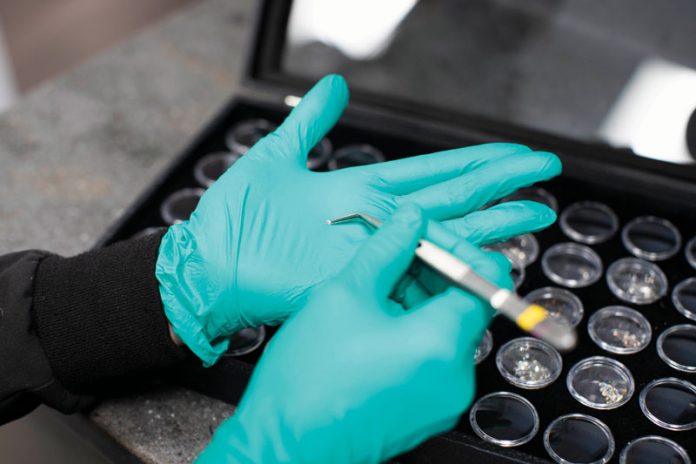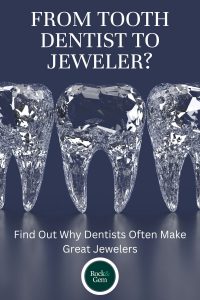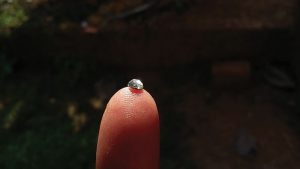
From tooth jewelry dentist to jeweler? It may seem like quite a career shift, but dentists often make great jewelers because they have the skills to work with lapidary materials and the knowledge of these materials and where they work best.
Back in the 1970s super rocker, Mick Jagger, dominated the gossip columns when he reportedly asked his dentist to fill one of his molars with a ruby.

Dental Decor History
While there is no way of knowing if Jagger’s dentist complied, the notion of using gold, crystals and precious gemstones to decorate teeth is far from new. Native Americans decorated their teeth with gold and precious stones as many as 2,500 years ago, according to dental hygienist Brooke Sergent, a writer for RDH, a digital media company for dental hygienists.
“Dental decor was predominant in men, and ornamental stones such as jade, turquoise, gold and hematite were applied to the teeth using natural resins (plant sap) mixed with other chemicals and crushed bone,” Sergent wrote in RDH’s September 2021 online issue.
In 1178 Chinese explorers reported finding some Philippine mountain tribes displaying “pegged-gold teeth” to intimidate their enemies and to testify to their status within the tribe. “Archaeologists suggest that gold plates were hammered onto the teeth or were adhered by drilling holes into the teeth,” Sergent wrote.
Later according to archaeologists, members of one tribe decorated their teeth with a pattern of fish scales made of gold.
“Archaeologists believe a higher social class only wore this type of decoration after examining the graves,” Sergent wrote in RDH online. “This ornate detail was a status symbol that was achieved by intricately placing individual gold scales on the teeth after drilling holes.”
Tooth Jewelry Trends

These days the application of gold and gemstones to teeth has less to do with social status than with what’s trendy.
According to Tiffany Matrone owner of Bang Bang Body Arts, a custom tattooing, permanent make-up and body piercing studio in Northampton, Massachusetts, the appeal of tooth jewelry is wide.
“Celebrities have shown off their tooth jewelry in (fashion), and other high profile magazines,” says Matrone “Our clients range from young men and women to older women and men.”
Dentists Offering Tooth Jewelry
Matrone is one of an increasing number of aesthetic professionals who offer the application of tooth jewelry to their clients. Most often those applications include gold symbols ranging from dollar signs to shooting stars, to hearts, to the signs of the zodiac and more.
These so-called “charms” are generally made of either 22-karat yellow gold or 18-karat white gold, between 1.90- millimeters (mm) and 5-millimeters (mm) in size and fashioned with a flat-back surface to facilitate bonding. The charms are then affixed to the teeth with dental bonding glue.
Crystals are applied in the same fashion but, Matrone says, the kind of crystals that aesthetic professionals use makes a difference.
“We use only Swarovski Crystals because they have a backing that is safe to be used in the mouth,” she says. “Some crystals are lead-backed and that is not at all safe.”
Invented in 1892 by Daniel Swarovski, Swarovski crystals are man-made gems manufactured in Austria using specialized equipment to precision cut crystals using quartz and sand.
Swarovski crystals rank 6 to 7 on the Mohs scale which rates the hardness of gemstones according to how scratch-resistant they are.
Due in part to their hardness and durability, Swarovski crystals are preferred by jewelers, as well as by those who apply them to teeth, says Dr. Robert Scheele DDS, a dentist in private practice in Fort Wayne, Indiana.
“The crystals are stain-resistant, are hard enough, and have no effect on tooth enamel,” Scheele says. “Applications can last 30 days or longer.”
Filling Cavities Decoratively
In her private practice, Dr. Katherine King DMD applies a wide variety of gold and precious gems to her clients’ teeth including using the materials to fill cavities.
“We do it all the time,” King says. “In fact, we have been asked to put some pretty interesting things into teeth.”
According to King, those things have not included rocks or stone materials, but they have included a range of gemstones. Some are obtained by the dentist through a jewelry supplier. Others are brought in by a patient wanting to make a statement or even memorialize a departed loved one.
“For example, it could be a (gem) stone that you got from a piece of your grandmother’s necklace,” she says. “What’s important is that the stone is not too large.” That’s because when a gem is used in a filling, it must be implanted into the dental material that will be used to fill the tooth.
“We start by first filling a tooth with a white filling material, then when you get to a point where it is appropriate, you embed the gem into the filling,” King explains. “If you have a faceted stone that comes to a point at the bottom, we might have to grind it down to flatten it.”
Most cabochon gems, those cut to have a convex top and a flat bottom, are also suitable to be embedded into a filling, she says.
Knowing the Mohs Scale
Hardness is also crucial. According to the International Gem Society (IGS) ranking 10 on the Mohs scale, a diamond is the hardest of gemstones. Rubies and sapphires, also known as Corundum stones, follow ranking 9 on the hardness scale. By contrast, emerald rates 7.5 to 8 on the scale.
“When you’re filling a tooth with a gemstone, the harder the gemstone is the better,” King points out. “For example, an opal would be way too soft.”
Similarly, gemstones may be also bonded to teeth, usually on either the left or right sides of a front tooth, or on a tooth at the very front of the mouth.
By far though, King’s patients have requested that gold be either applied to their teeth, exposed in a dental crown or simply used as a filling material.
“For example, I use it when I cast a crown, or to fill a tooth, but I won’t create a crown or a filling unless the tooth needs it,” says King.
When she does use gold for those purposes, King says that like gem materials, hardness counts. That’s because gold applied to the mouth must be able to withstand years of exposure to acidic fluids that either occur in the mouth naturally or are introduced into it, as well as to hold up to nearly constant chewing and grinding.
“That’s why anything less than 24-karat gold is much too soft,” she says.
At a time when many patients want their teeth filled as inconspicuously as possible with white filling material, others want to show off a mouthful of gold fillings.
“I had one patient who wanted his entire mouth filled with gold,” King recalls.
Still, others want a range of symbols made of thin 24-karat gold bonded directly onto their teeth.
“I’ve had people ask for everything from the Playboy logo to a cross bonded to their teeth,” she says.”I’ve had patients request to have gold embedded into their partials and dentures, too.”
Ultimately, whether applied by a dentist or an aesthetic professional, Scheele says interest in tooth jewelry is on the upswing.
“I started making the applications available about two or three years ago when some members of the staff suggested it,” he recalls. “Since then, we’ve had some women in their 50s and some middle-aged men. As a trend, it’s not going away soon.”
This story about tooth jewelry dentist to jeweler appeared in Rock & Gem magazine. Click here to subscribe. Story by Pat Raia.














